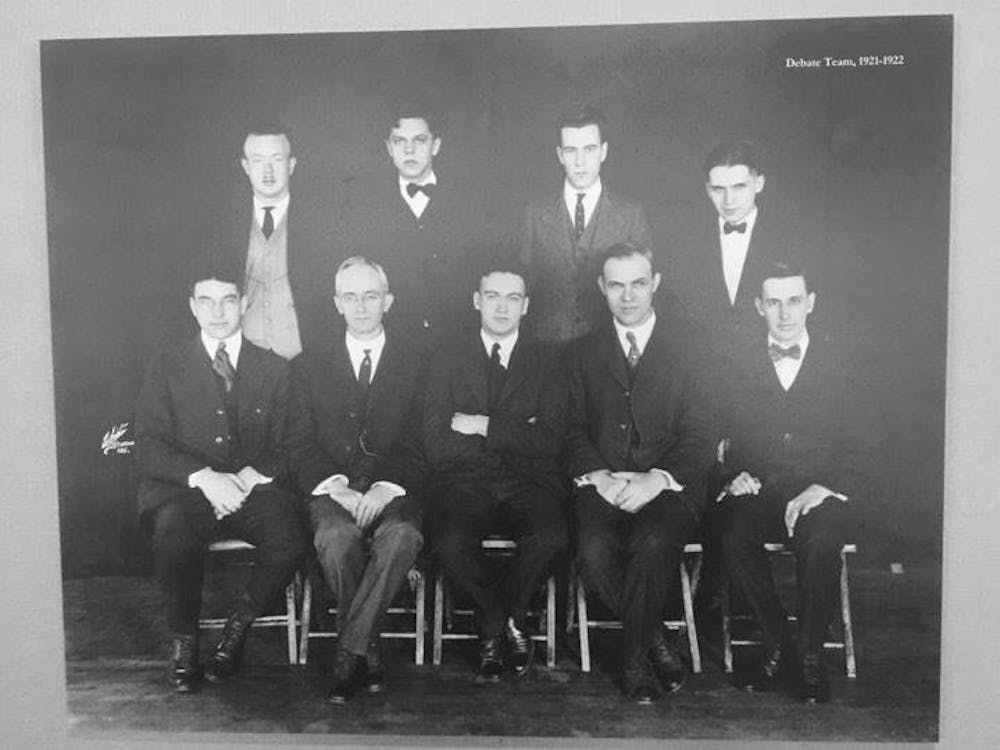The Middlebury Debate Society is one of the oldest extant student organizations on campus. It has been around for over one hundred years, and was founded around the same time as the Campus itself. Although there has been some sort of debate team around for the past century, it has morphed several times. Today’s society only vaguely resembles the debating clubs of the past.
The exact founding date of the first Middlebury debate team is unknown, but the first active club appears to have begun in 1912-1913, formed by members of the class of 1916. In one of the earliest mentions of organized, competitive debate, a writer for the Campus said, “Members of the class of 1916 interested in debating met some time ago and organized a Freshman Debating Society.”
This first group of students organized mostly for intramural debate, planning a series of topics on current events such as “Resolved: That the U.S. Government should own and operate the railroads.” Although this is an issue specific to their time period, some of their other topics resonate much more with the current political climate. For example, their next debate focused on the topic “Resolved: That the U.S. Government should further restrict immigration.”
Both the students involved and the writer of the article hoped that the debate team would grow into something larger. At the end of the article, the reporter said, “With the material on hand it is anticipated that a credible team will be developed to maintain Middlebury’s standard against her ancient rivals from Northfield.” Northfield presumably refers to Norwich University, which is located in the town and has historically been athletic rivals with the College.
For several years after its inception, the debate team remained an exclusive pastime of first-years. It retained the name “Freshman Debating Society” for some time, although it is uncertain for how long. However, some students were already pushing for a larger, school-wide debate team a month after those first articles about the first-year organization were written.
In an article published in May 1913, a Campus reporter said, “The freshmen have been energetic and brave enough to go forth, survey carefully, and win a good fight in the field of debate. We should, by all means, follow their example and as a college send out men who by intellectual powers and strength of oratory could tack more victories to our record.”
By 1922-23, the society was simply called the “Debate Team,” and appears to have included multiple class years. A photograph of eight debaters and their faculty advisor still hangs on the wall of the Kirk Alumni Center, one of the few hints of early debate artifacts that still remain on campus. After this point, it turned into an established rhetoric organization and held several debates a year.
These debates were big events on campus: they were held in Mead Chapel, the President of the College presided over them, and on-campus musical clubs were often invited to play. Later in the 1920s and in the 1930s, a women’s debating club was founded. Men’s debates had an entry fee of 25 cents, while women’s debates were free. According to documents in the College’s special collections and old Campus articles, the team’s main events seem to have been these scheduled, large-production debates.
They did not simply debate against themselves, either. The College’s debate team invited other organizations from all over the country and even overseas. On Nov. 14, 1934, for example, student debaters from the University of Oxford traveled to the College to debate the topic, “Resolved: that the abandonment of an isolationist policy is essential to American recovery.” Other invitees included a mixed team from Scottish universities, Cambridge University’s team, and a team composed of College faculty members.
The College’s team was able to afford these events because a wealthy alum of the University of Vermont took an early and passionate interest in helping Vermont debate survive and grow. It is nearly impossible to tell when this alum, Edwin Lawrence, began donating to the debate team, but former Debate Society captain Nate Rifkin ’15 believes that he set up an endowment around 1915-16. Associate Dean of Students for Student Activities and Orientation Derek Doucet has traced it back to an original $1000 gift in 1922.
This endowment originally provided funding primarily for special prizes given to winners of tournaments, but over time, Lawrence increased the size of the endowment. It came to fully fund both UVM and Middlebury debate teams, and during the twentieth century, the College and UVM met in an annual Edwin Lawrence debate.
To this day, the Lawrence endowment funds the Debate Society and the Model United Nations team at the College. There is also a Lawrence Debate Room in Wright Theater, although the current Debate Society no longer uses it.
In 1981, the American Parliamentary Debate Association (APDA) was founded in an attempt to organize the disordered state of American debate. According to Rifkin, who studied APDA records while he was enrolled at the College, Middlebury’s debate team joined early on in APDA’s history.
However, it was not until recently that the society has found success on the circuit. Rifkin and Frank Wyer ’15 were the first College pair to make it to an “out” round (an elimination round) in a tournament, while Rifkin and James Callison ’17.5 were the first pair to win a tournament.
Alongside its recent successes, the Debate Society has grown both in membership and in scope. As a result of the Lawrence endowment and the demands of having to travel, the Debate Society now has a budget of over $50,000 a year.
This means that the leadership can send students to tournaments across the country and throughout the world. They have travelled as far as Malaysia, the Netherlands, and Jamaica, and continue to be yearly competitors at the Oxford and Cambridge tournaments.



